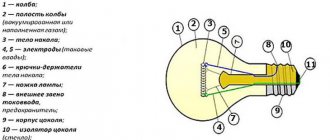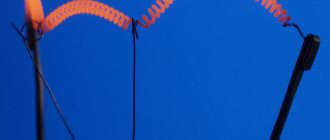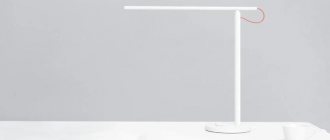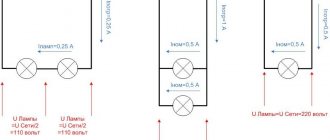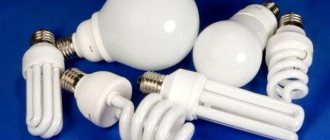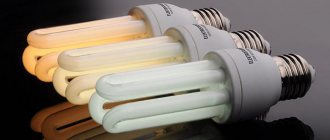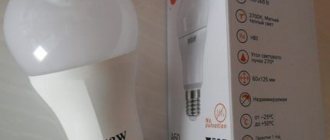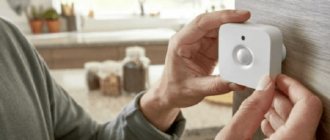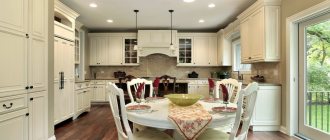Pet owners try to provide them with comfortable living conditions in a certain location. And if cats and dogs can move freely throughout the room, choosing the optimal place for themselves, then the same aquarium fish are forced to stay where their aquarium is located. In order for the inhabitants of an aquarium or terrarium to feel good in our climate, they need to create a certain temperature regime and type of lighting. Due to the fastidiousness of many aquarium inhabitants, aquarium lighting is selected in strict accordance with the standards and operating characteristics of lighting equipment.
Requirements and characteristics of aquarium lighting.
External lighting.
Plants need light for photosynthesis, and fish need it to form a life pattern. You should adhere to the following rules:
- protect the lamp with a waterproof casing;
- distribute light evenly throughout the volume of water;
- choose the right lamp power for specific flora and fauna;
- the lamp should produce a blue-violet and red-orange spectrum.
When choosing lamp power, you should consider the following important factors:
- type of fish and their habitat requirements;
- type of plants and their requirements;
- depth of the aquarium;
- water: sea or fresh;
- type of lighting in the room (artificial and natural);
- color and transparency of water.
It is quite difficult to take everything into account at once, so there are methods for calculating the required lighting power.
General characteristics of aquarium light
The main characteristic of aquarium lighting is power. You need to start by determining the correct lighting power. As you know, power is measured in Watts (W). There is a special calculation of lighting power depending on the volume of the aquarium.
Lumen (Ln) - using this unit of measurement, the amount of light that the lamp emits is determined.
Another characteristic of lamps is color temperature (K). Only the sun provides the full light spectrum of illumination, it consists of waves that in their combination produce yellow or white light.
But if you separate them, they will have different colors. Many aquarium lamps have parameters of 5500K, 6500K, 10000K, 20000K. This is their color temperature.
It is not recommended to choose lamps with a color temperature below 5500K. Because their blue-red rays promote the growth of algae.
If you have a shallow freshwater aquarium, you should pay attention to 5500-10000K lamps. Lamps over 10,000K have a very high light intensity and are only used for deep aquariums.
Spectrum (Nm). For aquariums, 2 narrow spectral ranges are used: blue-green (440-470 Nm) and red (660 and 700 Nm).
Selection of lighting.
Lighting distributions.
By volume.
The brightness of the light source can be too high or low and can harm the inhabitants of the aquarium. The lamp power can be selected according to the volume of water: approximately 0.1-0.3 W per 1 liter of clean water. In real conditions, it is difficult (and unnecessary) to keep water clean. Therefore, it is worth considering the type of fish and the number of plants that live inside. Recommended power values for incandescent and halogen lamps are given in Table 1.
Table 1.
| Lamp power, W/l | Type of plants and fish |
| 0,2-0,4 | For heat-loving, nocturnal fish, catfish. Plants that are little dependent on light. |
| 0,4-0,5 | Average value. Suitable for a variety of fish and small quantities of all plants. |
| 0,5-0,8 | For decorative aquarium plants. |
| 0,8-1 | For a large number of plants; for plants that grow in soil. |
For an average value of 0.5 W/l, Table 2 shows the lamp powers and their number depending on the volume.
Table 2.
| Aquarium volume, l | Lamp power, W | Number of lamps, pcs |
| 25 | 8 | 1 |
| 50 | 15 | 1 |
| 60 | 15 | 1 |
| 130 | 18 | 2 |
| 220 | 30 | 4 |
| 310 | 38 | 4 |
| 350 | 36 | 4 |
| 400 | 36 | 4 |
In depth.
You can choose the power for the light source based on the turbidity of the water. In a medium-transparent liquid, the brightness of light decreases by half every ten centimeters. For example, with an aquarium depth of fifty centimeters, only a quarter of the light reaches the bottom.
To maintain a healthy aquarium flora, the power of the lamps should be calculated so that the luminous flux at the bottom is over 60 lm. And the illumination value on the surface is recommended to be maintained in the range from 13 thousand lux to 18 thousand.
Despite all the mathematical calculations and calculations, the main indicator of the right light source will be the beautiful and healthy inhabitants of the aquarium. They themselves will tell you if the lighting is chosen incorrectly.
- when there is too much light, the water blooms, algae grows, and the walls of the aquarium turn green;
- If there is a deficiency, small plants die, brown spots appear, and fish lack oxygen.
Location of the backlight.
Illumination at high altitude.
It is important not only to calculate, but also to correctly place the light source. The best option is a lamp from above. There are two options for this arrangement: open and closed. The first type of lamp hangs above the aquarium. The second lamp is mounted in the lid of the container. The second option is cheaper and easier to use.
Reflectors are installed to distribute light evenly. This allows you to illuminate the most difficult to reach corners of the aquarium.
If, however, the bottom of the aquarium is in the shade, then you can install additional submersible lamps along the walls or on the bottom. The same technique is used as decorative lighting in the water column.
Keep in mind that a light bulb placed above water may generate excessive heat. To avoid overheating, you should move the lighting fixture higher or place a cooling cooler in the water.
How do you know if the lighting is correct?
The algae has an intense emerald hue with hints of brown, amber and purple. Exotic fish lead an active life, and their scales sparkle with sparkling shades. But due to various imbalances in the ecological balance, various ailments can occur. Ecobalance is affected by proper lighting and water pollution . It is not uncommon for the water to begin to bloom and become cloudy. This phenomenon indicates incorrect lighting. It provokes the active growth of pathogenic microorganisms. When aquarium inhabitants swim in polluted water only near the surface of the container, this indicates a lack of air and a strong excess of light.
If, after installing a homemade lamp, all aquarium inhabitants are still comfortable after 50-100 days, then this indicates the correct selection of optimal lighting. Necessary signs should be clear water and actively growing plants. Aquarium inhabitants must show interest in food. The appearance of new offspring should be observed.
With a lack of lighting, algae begin to lose their color. The appearance of plants begins to upset aquarists. A “black beard” forms on the stem and leaves. A dark coating indicates severe contamination of the container and lack of lighting.
Types of lamps for an aquarium.
Blue light source.
Fluorescent lamps [LL].
The lamp consumes little electricity and produces a good luminous flux. In addition, LLs are relatively inexpensive, heat up little and provide diffused light, which is suitable for most aquariums.
However, such a lamp must be connected through a special choke. This device is noisy and can harm fish. In addition, fluorescent light sources will have to be replaced once a year. This is due to the design of the LL: the phosphor layer that covers the inside of the flask quickly wears out and becomes unsuitable for flora and fauna. Lamps should be replaced one at a time, not all at once.
There are several types of LL that should be used for an aquarium. This is indicated on the packaging in the color designation: /xx. Xx are the following numbers:
- /03 – luminous flux suitable for light-sensitive plants (corals) and marine aquariums;
- /05 or /89 – light with a predominant blue tint (suitable for reefs);
- /79 – light with a predominance of red;
- /77 – universal aquarium light source;
- /54 – daylight;
- /35 – white light.
The type of glow is also indicated on the packaging: NO, HO and VBO. NO is suitable for small aquariums with a depth of no more than 50 cm. HO and VBO are more powerful.
Standard LLs of different diameters are available:
- 16 mm – “T5”;
- 26 mm – “T8”;
- 28 mm - “T12”.
The T8 aquarium lamp represents good value for money. T5 is more compact with a higher luminous flux (NO). But it requires a special throttle, so replacing one diameter with another will not work.
There are LLs with different bases. The so-called housekeeper has a standard base (E14 or E27) and a spiral-shaped flask. And the compact lamp is equipped with a special g13 socket, which is suitable for aquarium lamps.
LED lamps.
This is the most economical option: power consumption is low and service life is long. In addition, high-quality LED light sources heat up little, do not flicker, and shine evenly (reflectors are not needed). Light can penetrate to great depths. They are suitable for both sea and fresh water. When using LED strips, you can create a variety of decorative lighting modes. (However, this is a lot of stress for fish).
The negative aspects of using LEDs include the cost and lack of understanding of the effect of such light on flora and fauna.
You can study LED lamps in detail in the article: “How does an LED lamp work?”
Metal halogen lamps.
They are successfully used to illuminate aquariums above 60 centimeters in height. Metal-halogen light sources have a number of advantages: low cost, relatively low energy consumption, directional luminous flux, different color temperatures, small size, light is well perceived by fish.
The main disadvantage is strong heating. Therefore, they must be mounted at a distance from water (at least thirty centimeters) and turned off after two hours of operation to cool down. However, the lamp can be equipped with a fan, then you won’t have to turn it off. You should also put glass between the water and the lamp.
Incandescent light bulbs.
They, like halogen ones, are used less and less. Their main disadvantage is high heating and high energy consumption. Among the advantages, it is worth noting the low cost and the light spectrum as close as possible to the sun.
Blue lamp for an aquarium.
They are used to create the effect of the deep sea in the water column.
The use of such light sources depends on the type of fish that live in the aquarium. Blue light is “natural” for deep-sea and bottom-dwelling fish. For other marine and freshwater inhabitants, the blue spectrum causes discomfort. Therefore, it is recommended to use a blue lamp only in combination with a white one. Or to highlight certain areas of the aquarium. It is also worth keeping in mind that the blue, or more precisely blue-violet, spectrum helps the growth of plants in the aquarium.
Ultraviolet lamps also emit blue light. With their help, you can disinfect water from viruses and bacteria and reduce water turbidity. In addition, there are fish and plants that respond favorably to ultraviolet radiation and develop well in it. In addition, under ultraviolet light, many fish reflect a beautiful fluorescent light. But the light output of ultraviolet lamps is small, so it should only be used as local illumination.
Types of lamps used
If in Soviet times, aquarium lighting was provided exclusively by incandescent lamps, then with the advent of more efficient lighting devices in everyday life, the attitude towards this issue changed radically. It should be noted that uniform lighting must produce a certain amount of lux so that the inhabitants of the aquarium do not experience either a lack or an excess of light. This is especially true for aquarium plants; due to lack of light, they slow down their processes, cease to assimilate and may even die. If you install lamps with a reserve, the result of exposure to excess flow can cause:
- Disorders of nutrition and normal metabolism;
- Lowering leaves along the lines of light flow (as a defensive reaction);
- Uncontrolled growth.
Therefore, when choosing the type of lighting equipment for an aquarium, be sure to take into account the characteristics of the lamps used.
Luminescent
Fluorescent lamps use a mixture of gas and mercury vapor as a luminous flux generator. For lighting aquariums, fluorescent lamps are not bright enough, so they are installed in shallow aquariums with a depth of up to 50 cm. But there are also specialized, more powerful lamps for aquariums, designated HO (short for High Output) and VHO (short for Very High Output). They produce a much larger spectrum of radiation with the same dimensions. Luminescent models offer the following color spectrums:
- Daylighting;
- Natural spectrum;
- Blue spectrum (used for night lighting);
- With various shades.
The most common fluorescent type models are T5 and T8 tubular lamps, they differ in size and diameter of 16mm and 26mm, respectively. Classic housekeepers can also be used, but their installation is not always convenient. The disadvantage of fluorescent equipment is the gradual fading, which reduces the level of illumination, so they will have to be changed frequently.
Rice. 2: night lighting with fluorescent lamps
Metal halide
These are gas-discharge lamps that create a relatively powerful luminous flux that is pleasant for aquatic life. They illuminate the entire water column well and create an excellent play of light, which is widely used for reef aquariums. Unlike fluorescent ones, they can easily cope with a water layer of more than 60–70 cm. The disadvantage is the large amount of thermal energy, which is why they should be placed at a distance of at least 30cm from the surface.
Metal halide lamps for aquarium lamps should be chosen with a small power reserve, as they burn out over time. And the luminous flux for a home aquarium, during the entire period of operation of such a lamp, should be adjusted by the height of the aquarium lid. The power of specific models varies from 70 to 1000W.
LED lightening
LED lights are made from semiconductor crystals and are increasingly being used to illuminate aquariums. Their main advantage is fairly high performance in relation to the electricity consumed. This provides significant savings during long-term operation of lighting devices.
Rice. 3: LED lighting
Example of LED aquarium lighting
Due to the compactness of the crystal, it is used in:
- LED spotlights – for the central lamp;
- LED lamps - are used for artificial illumination of various shapes;
- LED strips – for LED illumination of various areas of the aquarium.
LED lighting devices also have a wide variety of shapes, so in addition to their main function, they are often used for decoration. Additionally, LED luminaires easily adjust the lighting mode and flow rate. This makes them great for beginners who are unsure of their power calculations.
Incandescent lamps
This is a classic option for making a lighting system that uses the conversion of electrical energy through a filament into a luminous flux. Their main advantage for marine life lies in the maximum proximity of the spectrum range to natural sunlight. The disadvantages include extremely low efficiency, since in relation to the power consumed from the network, only 3% is converted into light, and the rest turns into heat. Therefore, for incandescent lamps it is necessary to organize additional heat removal from the working surface.
Rice. 4. Incandescent lighting
Selecting lighting devices by color temperature
But, in addition to the type of lighting equipment for underwater inhabitants, it is important to choose the right light temperature. This parameter is measured on the Kelvin scale and compared with natural sunlight. It differs for different types of lamps
Rice. 5: color temperature spectrum
At a color temperature of 5500 K, all objects will be perceived in their natural colors. If this parameter is lowered, all objects will have an orange and red tint, and if the color temperature increases, they will begin to acquire cooler blue shades. An example of color perception distortion, depending on color temperature, is shown in the figure below:
Rice. 6: Color distortion depending on color temperature
Since color temperature significantly affects lighting modes, the table below shows comparative characteristics of different types of lamps.
Table: comparison of different types of lamps for aquarium lighting
| Lamp type | Color spectrum, K | Intensity | Aquarium type | Advantages | Flaws |
| Incandescent lamps | 2700 – 3000 | Low | Small aquariums that do not require high radiation levels, reptile terrariums | Cheapest, available, various colors. | Poor spectrum, promote algae growth, generates a lot of heat, ineffective. |
| Fluorescent lamps (NO) | 5500 – 10000 | Low | Small aquariums with freshwater fish | Low price, available, various colors, types, effective. | Not suitable for use in deep water pools (light will not penetrate) |
| High Output (HO) or Very High Output (VHO) fluorescent lamps | 5500 – 10000 | High | Aquariums with freshwater marine fish and reefs | Smaller and brighter than conventional fluorescent lamps | Special lamps required |
| Compact fluorescent lamps (CFLs) | 5500 – 10000 | High | Any | Reasonable price, universal, long service life | More expensive than fluorescent lamps |
| Metal halide lamps and HQI | 5500 – 20000 | Highest | Aquarium with coral reefs, organisms that need a lot of light, plants | Optimal for deep-sea aquariums | High purchase and replacement costs |
Combined lighting.
According to aquarists, the most effective lighting is provided by using different types of light sources. The main task when mixing remains to obtain a spectrum as close as possible to the solar one. When selecting light bulbs, it is necessary to take into account the color temperature.
Most often, the combination is based on fluorescent lamps. LED or metal halogen light sources are added to the LL. There is a combination of three lamps: LL, metal halogen and LED.
Light spectrum.
Colorful temperature.
In a natural body of water, the sun's rays lose part of their spectrum when passing through the water column. The red and orange part is absorbed in the first five meters. After nine meters the yellow spectrum is lost. An aquarium of such depth can only be found in an aquarium. In most aquariums, the light reaches the bottom in the full spectrum.
Experts advise using lamps with a color temperature above 5000 K (blue-violet spectrum). This will create good color rendition in the water and allow plants to develop better.
No lamp can completely replace sunlight. Fluorescent lamps are as close to the “ideal” as possible. Especially their newest type: phytolamps.
Calculation examples. Aquarium 100 liters.
№1. An average illumination of 50 lm/l is required, a total of 50 lm/l * 100 l = 5000 lm. There are LED lamps on sale with the lumens indicated on the packaging - 10W (800lm), 20W (1600lm). This means that we will need three 20W spotlights, which in total gives 1600lm + 1600lm + 1600lm = 4800lm, which is practically what we need.
№2. Moderate illumination of 35lm/l is required, total 35lm/l * 100l = 3500lm. We select the power and number of fluorescent lamps. It’s a little more complicated here, since with higher power the length of the lamp also increases, because you can’t build a lamp with a length of 895mm into an aquarium with a length of 600mm. But let’s ignore this for now, we only count power and quantity. JBL T8 lamps are on sale - 15W 438mm, 25W 742mm, 30W 895mm, 36W 1200mm and others. Let's say we are satisfied with lamps 742 mm long, 25 W each, according to the conversion table, 25 watts of a fluorescent lamp are equal to 1200 lumens, it is obvious that we will need three lamps 1200 lm + 1200 lm + 1200 lm = 3600 lm.
№3. A high 100lm/l is required, a total of 100lm/l * 100l = 10,000lm. LED lamps with a color temperature of 6500k are on sale - 10W (800lm), 20W (1600lm), 30W (2400lm), 50W (4000lm). This means that we will need 4 30W lamps, which in total gives 2400lm + 2400lm + 2400lm + 2400lm = 9600lm. Or 2 of 50W and 1 of 30W, for a total of 4000 + 4000 + 2400 = 10400lm.
Long-term illumination of the aquarium.
Outdoor Lighting.
The operating time of the light sources depends on the type of fish living in the aquarium. It is necessary to create conditions close to their habitat. However, most aquarium fish come from the sunny tropics. Daylight hours all year round there last half a day: 12 hours. Therefore, the aquarium needs to be illuminated for at least 8-10 hours a day. Turn lamps on and off according to a schedule.
Control is simplified by placing the aquarium on the sunny side of the room: it is enough to turn on the backlight shortly before dusk. If the room is dark, then the lamps should work all day.
When organizing the light regime, you should adhere to the natural solar cycle. At noon, when the sun is at its zenith, the most intense lighting is needed for 3-4 hours. And in the mornings and evenings the light can be softer and subdued. To create such effects, different controllers are used.
Sources of light
Lighting sources for an aquarium are:
- natural;
- artificial.
Is a natural source necessary?
Natural is daylight , it is used as an additional stimulation for the growth of aquarium plants and during fish spawning.
IMPORTANT! It is not recommended to install the aquarium in a place that is exposed to constant sunlight. Sunlight is an excellent stimulus for the growth of green algae.
At the moment, there are many types of artificial lighting. For aquariums are used:
- incandescent lamps;
- LED bulbs;
- fluorescent lamps;
- energy-saving lamps;
- special professional light sources
Incandescent lamps
However, in aquarium farming they are used due to the fact that their spectrum is as close as possible to natural light. But this lighting device has a very low efficiency and many incandescent lamps are needed to grow aquarium plants. A large number of lamps will generate a lot of heat, which can negatively affect the aquarium climate and water balance.
LED modules and strips
Quite expensive, but more efficient lighting.
Aquarists often use them in combination with energy-saving lamps. LED lamps have low power. And they are often unable to provide large aquariums with sufficient light on their own.
However, high-power LED bulbs have begun to appear on the modern market, which over time may find wide application in the world of aquarium keeping.
Fluorescent lamps
Most commonly used in the aquarium world. Their advantages are considered to be cost-effectiveness and a fairly long service life.
Energy saving
Gaining popularity among aquarium lovers. Their use in lighting helps save energy and helps achieve optimal lighting conditions. These lamps have high light output, so two or three 18-20 W bulbs are enough to illuminate a 150-200 liter aquarium.
Special light sources are used in professional aquariums . These lamps can have a specific light spectrum, selected for a specific type of aquarium and plants.
All lighting options can be made with your own hands. There are many videos on this topic. Here is one of them:
Daylight hours and control options
For the harmonious operation of the aquarium, it is necessary to correctly determine the daylight hours. Lights must be turned on according to a schedule and for a certain number of hours . The optimal duration of daylight hours is within 8-10 hours. For herbal aquariums it can be 12 hours.
There are special devices for monitoring daylight hours. These are time relays or timers. They are electrical and mechanical. Using these devices, the lighting in the aquarium is automatically turned on and off.
In principle, night lighting is not required; it can be used only for beauty and when to turn it on is up to you. If your light bulbs stop shining, repairs will not be difficult . Usually this problem is solved by buying a new one.
Options for controlling daylight hours.
Daylight control using instruments on the bottom panel.
To create the optimal light mode, you will need several lamps, each of which is regulated by a separate toggle switch.
For ease of use, you can automate the process of turning the backlight on and off. It is enough to build a temporary relay or timer into the circuit and program it.
A timer is the simplest control device. There are timers that are designed to work in an aquarium. You just need to install them and set the desired time to turn the lighting on and off. The advantage of the timer is that it works in real time. If you need to turn on the aquarium at 7-25, then this is the number you dial on the device.
Relays do not have this function. The control is set logically: the process will begin after the required time interval. (For example, turn on the light after 8 hours, and turn off after 10). But when there is a voltage drop in the network, the relay program does not get lost. Devices are divided into mechanical and electronic. In the latter case, the lighting intensity is programmed.
Control devices can be installed on an outlet or in a panel. The first method is cheaper and simpler. The second is possible only at the stage of laying the wiring; this reduces the number of wires.
Common mistakes.
The brown color of the grass indicates a lack of light.
- You should not increase the operating time of lamps when their power is low. This will cause the water to bloom.
- Low color temperature of the light source leads to active growth of algae.
- Any excess is harmful: both too high light intensity and too low. In both cases, diseases of fish and plants and impaired photosynthesis are possible.
- Inconsistency between light conditions and the habitat of fish and plants.
- Incorrect placement of plants in the volume of water in height (for example, placing bottom plants on top).
Is it worth ordering lamps from Aliexpress?
Novice aquarists try to save money on purchasing a lamp for plants, which forces them to look for the product in Chinese stores, on the Aliexpress website. Of course, there are universal models there. However, they have disadvantages:
- Chinese LEDs are of low quality and are not intended for long-term use;
- light bulbs overheat quickly, which leads to combustion;
- The declared characteristics of the devices are greatly overestimated, so the use of intense light leads not only to the development of algae, but also to the death of vegetation.
A competent approach to choosing a lamp is required. After all, an incorrectly selected device will not only not provide a healthy microclimate in the tank, which will lead to negative consequences, but can be dangerous for the owner.
For beginners who want to grow plants in an aquarium and create exclusive living compositions, some advice would be helpful - take the time to fully study the material. It is better to spend months reading useful literature, slowly selecting the appropriate equipment and choosing the one on which the appearance of the entire aquarium composition will depend.
What kind of lighting is in your aquarium? What parameters were used to select it? Share your experience in the comments.
Favorable lighting for plants in the aquarium.
Herbaceous aquarium.
Plants absorb light to initiate the process of photosynthesis, without which their growth is impossible. The intensity of development depends on the presence of blue-violet and red-orange parts in the spectrum.
Depending on the type, plants require different amounts of light. With the help of reflectors, you can focus light flows in those parts of the aquarium where brighter lighting is needed. At the same time, fish that do not need as much light can hide in shady places or under the wide leaves of plants.
It is worth considering the height of the aquarium. It is better to plant plants that do not require light in high containers at the bottom.
Like most fish, much of the flora comes from the tropics. Therefore, they need a long daylight hours: 8-12 hours.
DIY aquarium lighting.
The easiest option for creating lighting yourself is to use a household lamp. For it you need to make a lampshade, reflectors and figure out how to attach it to the aquarium. When choosing a lamp, make sure that the base matches the base of the lamp you will use.
How to make a LED lamp for a marine aquarium is discussed in detail in the video:
You can also make the backlight in the form of an LED strip. To do this you will need: led tape, a plastic cylindrical flask of the required length, a 220V or 12V power supply, a soldering iron, an awl, silicone, pieces of foam rubber, a two-core wire and connectors for connecting the tape to the power supply.
DIY light source.
- Use an awl to make a hole for the wire in the lid of the flask.
- Solder a wire to the LED strip. On the other side, attach the wire to the connector using clamping screws.
- Glue pieces of foam rubber to the back of the LED strip. This is necessary so that the tape does not dangle in the flask, but is fixed.
- Place the tape in the flask. Seal the joints with silicone.
- Connect to a power source and check operation.
Place for placing lamps
In an aquarium, lighting is usually placed at the top, in the lid of the tank. In this place, you can install regular or long light bulbs, and for proper distribution of light rays, the pond is supplemented with reflectors. If lamps that generate a lot of heat are used for an aquarium with plants, then experienced owners place fans nearby for cooling. In order for the light to reach the bottom of the tank, lighting is installed on the side or at the bottom of the tank, but the upper illumination of an artificial reservoir is considered more accurate.
